Continuing the ongoing series of interviews on screen graphics and user interfaces in movie and television productions, it is my pleasure to welcome Alan Torres. Just in the last few years you’ve seen his work on “Iron Man 3”, “Captain America: The Winter Soldier”, “Guardians of the Galaxy”, “Hunger Games Mocking Jay”, “Furious 7” and, most recently, “Avengers: Age of Ultron”. In this interview Alan talks about the proliferation of screens around us and how that propagates into the make-believe worlds of movies, the collaboration within the studio that works on the interfaces and with other key people in the larger film production, joining the Marvel universe and to evolve and redefine the visual language established on the franchise, his work on the screens of “Fast & Furious 7”, keeping up with interface trends in the realm of real-life software, and his thoughts on holographic, augmented and virtual interfaces for our everyday interaction with information around us.
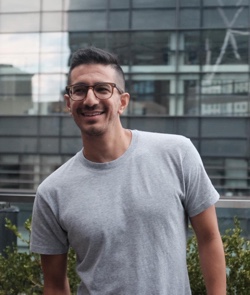 Kirill: Please tell us about yourself and your professional path so far.
Kirill: Please tell us about yourself and your professional path so far.
Alan: I grew up in Oxnard, CA, just a little more than an hour north of Los Angeles. I’ve always been drawn to creativity and art. I spent most of my childhood and high school years playing sports, watching movies and doodling in sketchbooks/textbooks. So after high school I decided to pursue a career of creativity at Otis College of Art and Design in Los Angeles. I majored in Digital Media and was completely fascinated with 3D/character animation.
After Otis I freelanced as a CG Artist for about 7 years before my creative focus began to segue into design. I loved the idea of dictating the aesthetics of any giving job from the start. In 2012, I teamed up with the talented crew at Cantina Creative in Culver City for about 8 months on the Avengers. This job was my introduction to film and the start of a relationship that continues today. Since the Avengers, I’ve had the opportunity to collaborate with Cantina on several productions including Iron Man 3, Captain America: The Winter Soldier, Need For Speed, Guardians of the Galaxy, Hunger Games Mocking Jay, Furious 7 and Avengers: Age of Ultron. In 2014, Cantina brought me on full-time as a designer.
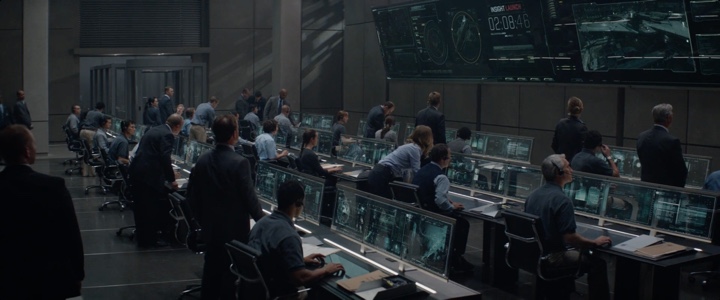
Monitors in “Captain America: Winter Soldier“. Courtesy of Alan Torres and Cantina Creative.
Kirill: What drew you into the movie industry? If you go back to the time when you just started on your first feature film productions and some of the expectations that you had, how close (or far) has the reality of working in the industry turned out to be?
Alan: It’s always been dream of mine to get the opportunity to work on a feature film. But I can say early on in my career I didn’t think my chance would come via UI design, let alone being a part of the team responsible for bringing Ironman’s HUD to life for the Avengers. Going into it I thought how great it would be to work on something so high profile, how satisfying it would be to have your work seen on such a big stage.
I was excited, and eager to experience the process of working on a feature. I learned quickly that this was going to be a very different process from working on commercials. It was a much slower burn, but I found that to be quite refreshing, especially after the sometimes impossible demands of commercials. Overall, I came to find the process extremely inspiring. And with so much left to learn, every day brings new challenges. Oh yeah, and getting to see you and your team’s hard work on the big screen is pretty cool.
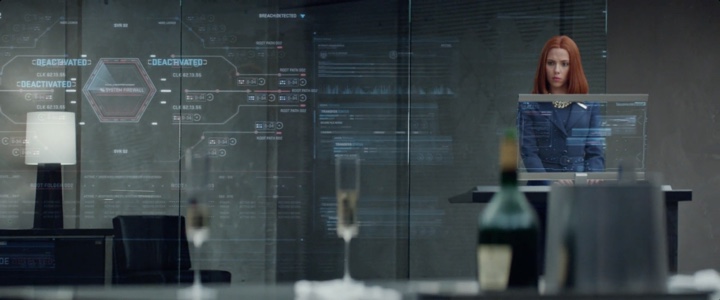
Screen graphics in “Captain America: Winter Soldier“. Courtesy of Alan Torres and Cantina Creative.
Kirill: When do you usually get involved with a production and what is the initial exploration process on your side of things? How much of that exploration makes it through to the final cut and how much is discarded behind?
Alan: We are post production. Conversations start between us and production around the time they are wrapping up shooting. Our exploration starts with an introductory/creative dialogue between us (Cantina Creative) and the VFX Supervisor on the film. The early meetings are all about gathering information and creative direction from the client.
From there we assemble our team and start developing various ideas and concepts that can help push the story. The initial concepts aren’t entirely what sticks, but to offer up a variety of directions that that client can pick from. Many ideas and designs get dropped in the process…which sucks to see as an artist, but you have to be able to see the bigger picture and understand that if your work isn’t explaining or enhancing the story, than there’s no logic in it being included.
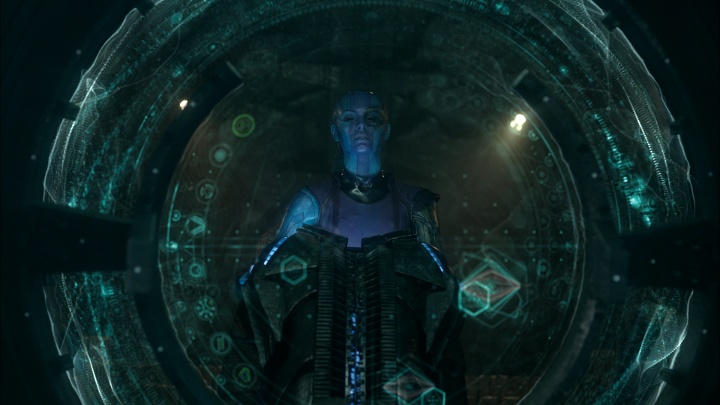
Early UI visuals for “Guardians of the Galaxy“. Courtesy of Alan Torres and Cantina Creative.
Kirill: It feels that with so many screens around us in our daily lives, it’s hard to imagine a film set in the present or near future without screens. How do you push the envelope of portraying the technology on the big screen when there are so many advances that people see in their everyday lives?
Alan: That’s an interesting idea to think about actually. What’s interesting is that most film UI is beautifully dense by nature to help visually exaggerate the story being told on the screen. So we consume it as “wow, look at how hi tech that is.” I wouldn’t says this goes for all…but most – when in reality, having mass amounts of data or imagery say..on our phone would be extremely distracting.
So the trends in real world applications are taking on a more minimalistic and intuitive aesthetic. However, I do believe that some of the tech and UI concepts that have been developed in film have had great influence in real world tech. But it’s not every feature gives you the chance to create something so advanced. What the film requires is a huge influence on how far to stretch the technological language. So conceptually speaking, we keep in mind what’s been done and how can we make it better. Or… just plain cooler.
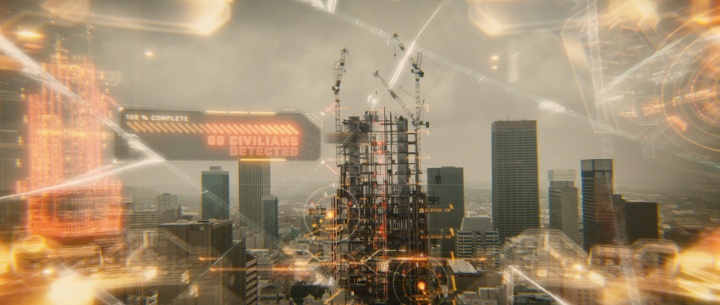
MK44 HUD interface for Ironman on “Avengers: Age of Ultron“. Courtesy of Alan Torres and Cantina Creative.
Continue reading »
Continuing the exploration of the world of episodic television in the ongoing series of interviews on screen graphics and fantasy user interfaces, it is my delight to welcome Seth Molson. In the last few years he has worked on “Sanctuary”, “Stargate Universe”, “Continuum”, “Intelligence”, “The Lottery”, “The Tomorrow People” and, most recently, “Dark Matter”. In this interview Seth invites us into the frenetic universe of episodic television, talking about different phases of the productions, keeping up with the pace of interface evolution on the screens around us, the difference between on-set and post-production work, his take on the term “fantasy UIs” and his thoughts on the real-world software tools.
 Kirill: Please tell us about yourself and your path so far.
Kirill: Please tell us about yourself and your path so far.
Seth: My name is Seth Molson and I’m a full time FUI designer / Motion Graphics artist working in Vancouver BC. Two of the last six years in the industry have been at SIM Digital in the playback division with a handful of other technical people, and I’m currently the only in house designer at the company. I guess you could say I also play pretty big creative role since I share my ideas directly with production designers and directors, and get a big say in what the content looks like. I grew up in the small ski town of Nelson BC where I studied Multimedia production and design. After receiving a BA in fine arts, I moved to Vancouver with hopes of joining a VFX team.
Kirill: What drew you into the industry? If you go back to the time when you just started on your first production (Stargate Universe) and some of the expectations that you had, how close or far has the reality of working in the industry turned out to be?
Seth: I originally wanted to be a VFX artist and after graduating university I had the opportunity to intern on Stargate Universe . I mostly spent my internship as a PA, putting up tracking markers and taking camera information from the camera operators. I didn’t really fit into the VFX pipeline because my knowledge was limited and it was a solid team already. I eventually found the playback department where I met Justin Kohse and Lisa Nolan. Justin was a motion designer at the time and Lisa was a 3d generalist who was transitioning out of playback. I think it was a mixture of luck and persistence, but I ended up joining the team full time for Season 2. The expectations were nearly impossible, but that’s what makes these environments so incredible; the teamwork and talent allows for anything to be created. There was a steep learning curve which I’m thankful for.
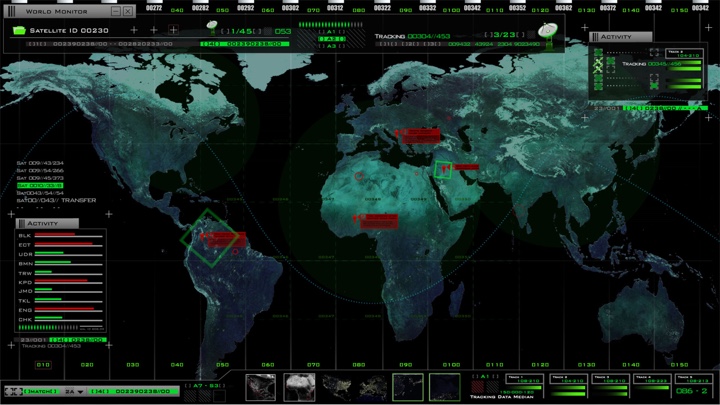
Ultra-map for “The Tomorrow People”. Courtesy of Seth Molson.
Kirill: When do you usually get involved with a production and what is the initial exploration process on your side of things? How much of that exploration makes it through to the final cut and how much is discarded behind?
Seth: When I worked freelance I would jump from production to production and pitch ideas in the pre-production/prep phase. It all depends on what is being asked for. A lot of what I create has to look realistic and simulate a real environment in the film/tv world. I would say that 70% of my job is a real world UI look and the other 30% is science fiction. When I get to work on science fiction content, I sit down with the directors and Production designers and hash out a look based on references and drawings of the sets and artistic look of the production. In most cases (knock on wood) my ideas make it through to the final cut but the frustrating part is that not everything makes it in front of the camera. I can spend a week working on a set and only 5/10 screens actually get seen in the shots. I usually concept in Illustrator because it’s faster for me than sketching on paper. The only time I will sketch is if I’m in a meeting with a director and he/she has many ideas of how a potentially big build is going to go. I will frantically scribble it all in to try and get their thoughts out on paper.
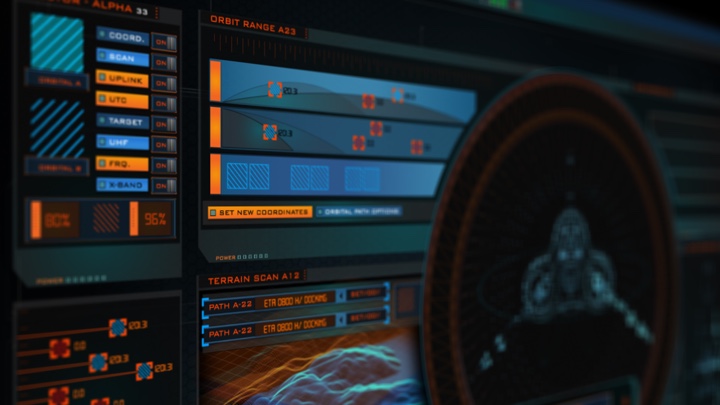
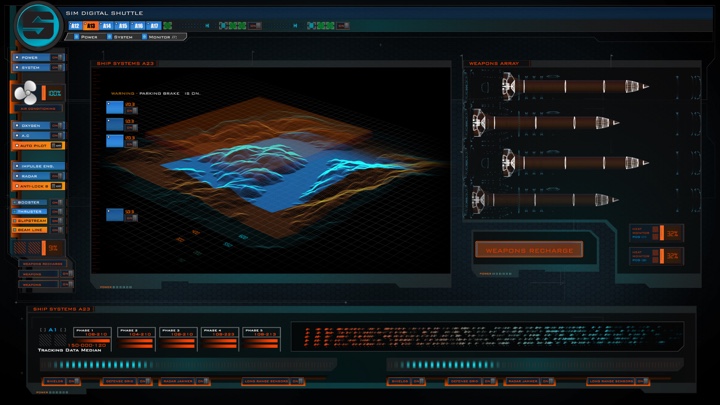
Screens for demo “SIM Shuttle” ship created for an open day at the studio. Courtesy of Seth Molson.
Kirill: It feels that with so many screens around us in our daily lives, it’s hard to imagine a story set in the present or near future without screens. How do you push the envelope of portraying the technology on the screen when there are so many advances that people see in their everyday lives?
Seth: This is a tough one, especially with all the current movies out right now where the UI is really pushing the envelop. I try and make something unique or use colors that aren’t normally seen in FUI / UI . Sometimes it goes and sometimes it doesn’t. Last year on “The lottery” I decided to use bright orange as the basis for desktop folders and icons and they loved it. Technology is advancing at an incredible rate and I recently looked back at my work from 2 years ago and thought it looked horrible. Styles keep changing and there will always be a dynamic flow to design.
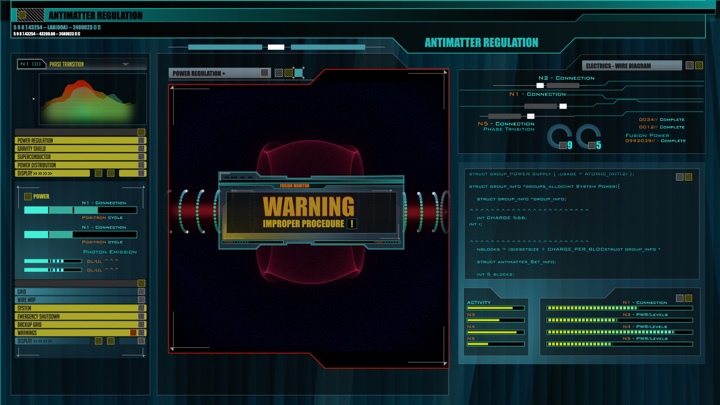
Anti-matter warning screen for “Continuum”. Courtesy of Seth Molson.
Continue reading »
Continuing the ongoing series of interviews on screen graphics and user interfaces in movie and television productions, it is my pleasure to welcome Robyn Haddow. While most of the recent interviews have focused on the work that goes into creating fantasy user interfaces for major sci-fi motion pictures, in this interview Robyn invites us into the frenetic world of episodic television. In the last few years she has worked on “The Flash” and “Arrow”, defining and evolving the world of screen graphics that follow characters through various major and minor sets across seasons that span 23 episodes each.
In this interview Robyn talks about the proliferation of screens around us and how that propagates into the make-believe worlds of movies and TV shows, the flow of work in episodic TV from fleshing out the initial brand to working on individual episode-specific sets with different directors and cinematographers, keeping up with interface trends in the realm of real-life software, her thoughts on the current generation of software tools she works with and how they can evolve, and the growing interest in human-computer interactions in augmented and virtual reality.
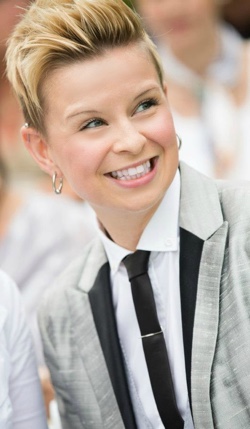 Kirill: Please tell us about yourself and your path so far.
Kirill: Please tell us about yourself and your path so far.
Robyn: I am a fantasy user interface designer and motion graphics artist for playback in production and post production in Vancouver, BC. I work at Scarab Digital, which is a content creation house, as well as freelance doing screen graphics and gadgetry for film, video game trailers and in game cinematics. I love imagination, collaboration and storytelling. I completed my University degree with a double-major in film and theater. After that I received a scholarship to go to the Vancouver Film School where I completed a diploma in the digital design program. There I gravitated towards motion graphics and stumbled upon the work of Mark Coleran. I was so intrigued and fascinated by some of the work Coleran had created for films such as “The Island”, “Mr. and Mrs. Smith”, and “Lara Croft: Tomb Raider.” I loved the detail and technical aesthetic. In doing more research in the field, I discovered work that Jayse Hansen had done in “Rise of the Planet of the Apes” and work that Corey Bramall was doing on features that was very inspiring to me. I was curious about screen graphics and wanted to pursue fantasy user interface design. I really love technology, and understanding how things work. I feel that UI design is a good arena for me because it is a vessel for both creativity and logic.
Kirill: It would also appear to me that the proliferation of screens around us in our daily work and personal lives has to be reflected in those movie and TV productions set in either present days or some variant of future. You have to have those screens that support the story and extend the “cyber” abilities of the characters.
Robyn: Exactly. Screens can also serve as a conduit for telling a story in a way that you can’t do otherwise. Sometimes showing a screen with a high-tech system serves as an outlet to provide an explanation of what happens, it’s a convenient way to get a story point across.
Kirill: And as we experience assistive screen based systems on our phones, tablets, cars and even in our homes, viewers come to expect to have those capabilities taken advantage of in the movie and TV productions.
Robyn: I think it also helps support the environments and the worlds set in films. It is an extension of believability of the story. If it’s set in the future, set in some sci-fi universe, as an audience you want to buy into their reality more. The technology in that world only helps to enforce that.
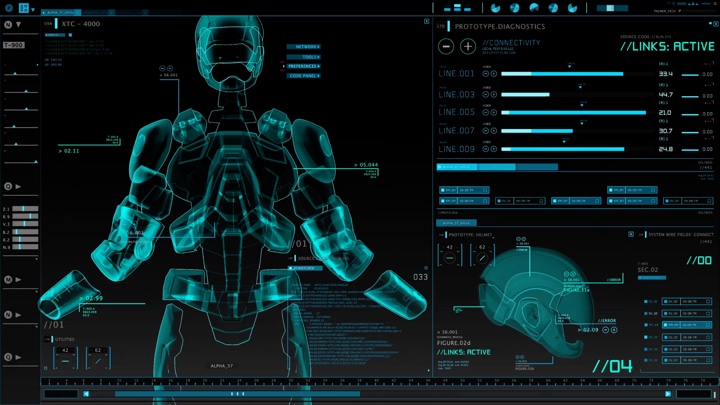
Screen graphics for Palmer Technologies in Arrow. Courtesy of Robyn Haddow.
Kirill: When did you switch to doing more work on screen graphics?
Robyn: Danny Ho, the Creative Director of Scarab Digital, reached out to me. He saw some of the work that I was doing, and thought I might be a good fit. He hired me to develop a lot of the screen graphics for the pilot of “The Flash” and I continued on with the success of that and the other shows at the time, season two of “Arrow” and “Tomorrow People.”
Kirill: What do you work off of when you work on a TV show? Do you get some kind of an initial brief that outlines the universe, and how much freedom you get to explore that universe within a certain set of story constraints?
Robyn: I get briefed from the concept and playback meetings where specifics from the production designer and director get flushed out, I read the script, go over any concept drawings and have a creative session with our team about how best to telegraph the script and make sure we are supporting the story the best way possible. We have earned a lot of trust and creative freedom of the course of the shows, and I feel very lucky for that. Our team is very collaborative and we work very closely on everything. Danny works very hard to maintain a positive energy and supportive environment in our team. It is so important as production moves so quickly.
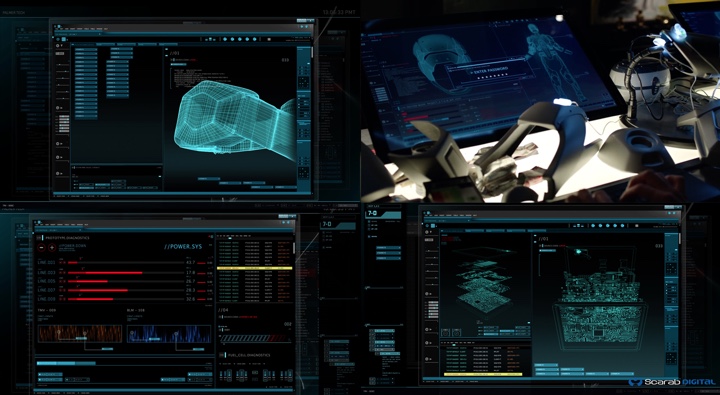
Screen graphics for Palmer Technologies in Arrow. Courtesy of Robyn Haddow.
Continue reading »
The last decade has seen a surge of interest in exploring holographic interfaces in major sci-fi movie productions. Anna Fraser is at the forefront of this wave, and you can see her work in “Ironman 3”, “The Hunger Games: Catching Fire” and “Insurgent”. In this interview she talks about what goes into creating holographic interfaces, from the initial exploration to subsequent collaboration with multiple departments, working within the post-production constraints of existing actor movements and eye-lines, her love of a strong grid and minimalistic, retro-futuristic interfaces, how people see and perceive color, and how the screen graphics work fits into the much larger flow of story-telling on the big screen. In the last part of the interview Anna talks about the evolution of technology on-screen as well as in real life, advances in virtual reality hardware and software, their possible implications on the fabric of our social interactions, and how, despite all the changes in the world of digital tools, the art of story-telling transcends technology boundaries.
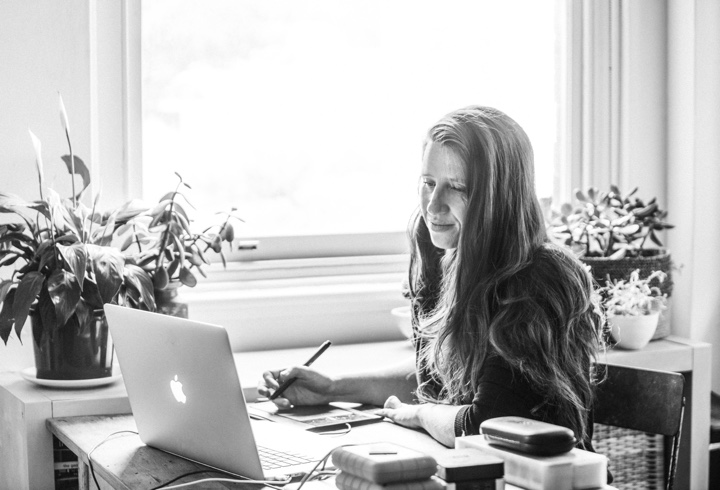
Kirill: Please tell us about yourself and your professional path so far.
Anna: My name is Anna Fraser and I live in Sydney, Australia, which is a long way away from America where these things are made.
If we’re talking about screen graphics and holograms, I ended up doing them kind of by accident. I originally studied visual arts, and I had a child when I was quite young. I was making art and having small exhibitions of bronze-cast sculptures and other things, but I couldn’t make any money. I had always liked movies so I decided to become a director [laughs]. Somehow I thought it was going to make me money; I’m not sure what I was thinking.
I went back to university and I did a communications degree in film, media and writing. A sort of a broad postgraduate, and then I started making short films. I then went to the Australian Film, Television and Radio School, which is one of Australia’s best film school. Everybody knew that once you got into the Film School, they would give you money to make films. You also didn’t have to pay money to go there, so I thought it was a great idea. I wanted to do directing, and that was hard to get into. It was very competitive, so the back door into it was to do another subject. I did digital media back then, around 2000, when it was starting to take off. I studied titles design, because I always loved graphics and text, and I was working doing part-time jobs in outdoor advertising and billboard art, which was very boring but functional in earning money. I still thought that I’d earn money being a director. I made some short films and they all had titles and graphics in them but they weren’t straight visual effects and they weren’t straight live action, but rather a combination of live action and titles.
I kept making short films and when I graduated I started working as a motion graphic designer as a day job. I thought it would be my day job and I would continue to make films.
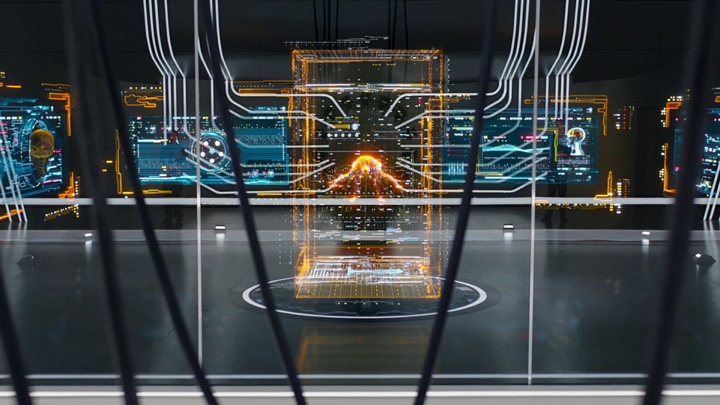
Kirill: And that was around time when computers got reasonably powerful and cheap to be able to afford having them as your own personal tool.
Anna: The first films that I’ve made were made on 16mm or 35mm film, but by then you could buy reasonable cameras that weren’t too expensive. I also had a lot of friends that were in the film industry, and you could always beg or borrow some ridiculous gear that you couldn’t afford.
Kirill: Back then you didn’t have the variety of digital cameras and tools available these days. It must have been more expensive to be an indie filmmaker 10-15 years ago.
Anna: I was working as a motion graphics designer and trying to make films and also being a parent. It was very expensive. You could often get good deals, but I spent an awful lot of money on films, which is silly really. Something had to give. So I decided, and I found it quite hard at the time, to not be a Director anymore, and just be a Designer. The Designer road is a hard enough in itself, and since I didn’t come from a traditional design background, I did a lot of learning on the job. I had all the formal qualifications of creating ideas and images, balance, shape, form etc. but it took me quite a while to understand the communication aspect of design. I made a lot of mistakes [laughs].
Kirill: Lucky for you there’s a lot of people on the production around you.
Anna: At that stage I was working in television, print and advertising, and I made quite big mistakes but I had good friends who, in one instance, did work out jobs for me and literally saved me. But I learned from them, and I learned from all the people around me.
I started doing a lot of freelance work for a company called Fuel VFX in Sydney. I worked for them on and off for quite a long time and I was getting better at being a Designer. I love film and the storytelling side of it, and fortunately for me Fuel was working on VFX [visual effects] and design for films. I mostly worked with Paul Butterworth who was one of the Founders & Directors at Fuel. He comes from a solid art and film training background as well and I found that it was good to work with him. I still work with him on all my film projects; he’s my main VFX supervisor and my main team member that I work with or for.
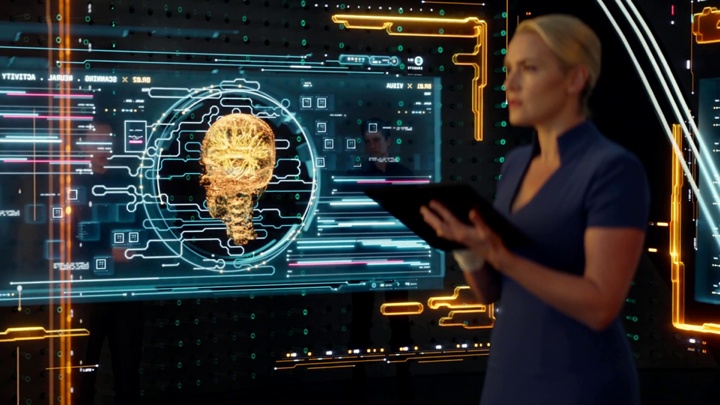
Continue reading »
![]() Kirill: Please tell us about yourself and your professional path so far.
Kirill: Please tell us about yourself and your professional path so far.![]()
![]()
![]()
![]()